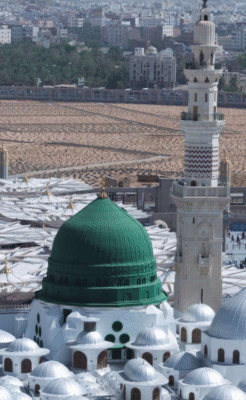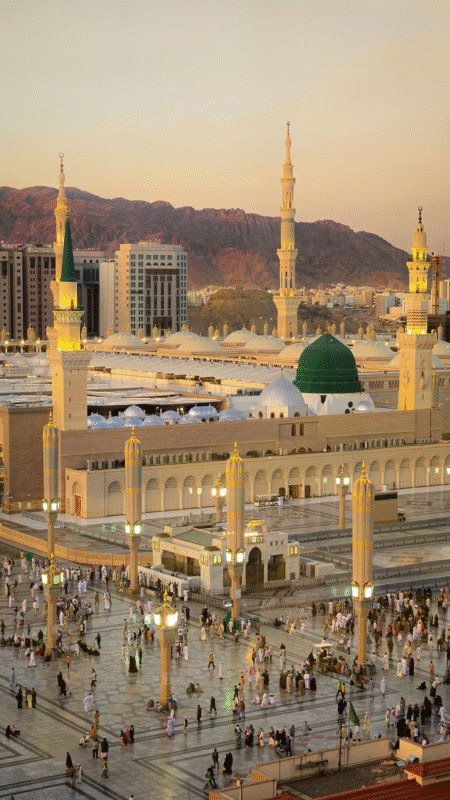The Historical Significance of Al-Masjid an-Nabawi in Medina
When travelers and pilgrims arrive in Medina, their hearts are drawn to one place above all others: Al-Masjid an-Nabawi, also known as the Prophet’s Mosque. This sacred landmark is not only a place of worship but also a living chapter of Islamic history, reflecting faith, unity, and the enduring legacy of Prophet Muhammad (peace be upon him). Its historical significance stretches far beyond its walls, shaping the lives of millions for over fourteen centuries
A Mosque Built by the Prophet Himself
The origins of Al-Masjid an-Nabawi are deeply personal. When Prophet Muhammad (PBUH) migrated to Madina in 622 CE, one of his first acts was to establish a mosque that would serve as a spiritual and community center. With his companions, he personally took part in building it, laying its foundations with simplicity—walls of mud bricks, a roof of palm leaves, and a humble prayer area.
This act showed that the mosque was not only about prayer but also about unity, cooperation, and service to others. The mosque became a symbol of how Islam connects faith with community life.
The Prophet’s Resting Place
Perhaps the most unique aspect of Al-Masjid an-Nabawi is that it houses the final resting place of Prophet Muhammad (PBUH). After his passing in 632 CE, he was buried in the room of his beloved wife, Aisha, which later became part of the mosque. Today, his grave, along with those of Caliphs Abu Bakr (RA) and Umar ibn al-Khattab (RA), lies under the iconic green dome.
For Muslims, standing near this sacred spot is a reminder of the Prophet’s life, his teachings, and his sacrifice for humanity. It is one of the most visited and revered places in the entire Muslim world.
Expansion Through the Ages
From its humble beginnings, Al-Masjid an-Nabawi has grown into one of the largest mosques in the world. Every era brought its own expansion:
- Caliph Umar ibn al-Khattab (RA)extended the mosque to accommodate the growing community.
- Caliph Uthman ibn Affan (RA)further enhanced its structure with more durable materials.
- The Umayyads, Abbasids, and Ottomans each added their architectural imprint, blending cultural beauty with Islamic devotion.
- In modern times, under the Kingdom of Saudi Arabia, the mosque has undergone massive expansion projects, welcoming millions of pilgrims each year.
This continuous growth shows how Al-Masjid an-Nabawi has remained at the center of Muslim life through changing times.
Center of Knowledge and Governance
In the early days of Islam, Al-Masjid an-Nabawi was not only a place of prayer. It was also:
- A school, where the Prophet taught his companions about faith, Quranic revelations, and moral guidance.
- A court, where justice was delivered with fairness and wisdom.
- A council hall, where important matters of governance were discussed and decisions made.
This multifunctional role highlighted the mosque’s importance as the heartbeat of the Muslim community.
The Green Dome – A Symbol of Love
The Green Dome, built during the Ottoman period, has become one of the most recognized symbols of Madina. It marks the Prophet’s burial chamber and is a visual reminder of his eternal presence in the hearts of Muslims. Millions of pilgrims look upon it with tears of gratitude and reverence, knowing it symbolizes the place where the Prophet rests.

A Place of Unity for the Ummah
Every year, Muslims from every corner of the globe—different cultures, languages, and traditions—gather at Al-Masjid an-Nabawi. Within its walls, all barriers fade away, and a sense of unity prevails. For many pilgrims, praying in this mosque is a lifelong dream, as it is considered the second holiest mosque in Islam after Masjid al-Haram in Mecca.
The experience of standing shoulder to shoulder with believers from across the world emphasizes Islam’s message of equality and brotherhood.
Spiritual Rewards of Visiting
Prophet Muhammad (PBUH) himself emphasized the blessings of praying in his mosque. According to authentic hadith, one prayer in Al-Masjid an-Nabawi is worth more than a thousand prayers offered in any other mosque, except for Masjid al-Haram.
This teaching elevates the spiritual significance of the mosque and makes it a place where pilgrims seek immense reward and closeness to Allah.
FAQs About Al-Masjid an-Nabawi
Q1: Why is Al-Masjid an-Nabawi important in Islam?
Al-Masjid an-Nabawi holds the honor of being Islam’s second holiest mosque. It was built by Prophet Muhammad (PBUH), serves as his burial place, and has been a center of prayer, knowledge, and unity for Muslims for centuries.
Q2: What is the Green Dome?
The Green Dome is the structure built over the Prophet’s burial chamber. It has become one of the most iconic symbols of Madina and a place of deep spiritual connection for Muslims worldwide.
Q3: Can anyone enter the Rawdah (the area between the Prophet’s house and pulpit)?
Yes, but entry is controlled to manage the large number of visitors. The Rawdah is considered one of the gardens of Paradise, and praying there is highly recommended.
Q4: How many people can the mosque accommodate today?
After modern expansions, Al-Masjid an-Nabawi can host more than a million worshippers at once, especially during Hajj and Ramadan.
Final Reflection
The historical significance of Al-Masjid an-Nabawi in Medina cannot be overstated. From the Prophet’s humble hands that built its foundations to its role today as a beacon for millions of believers, the mosque stands as a timeless symbol of faith, knowledge, and unity. For every pilgrim who enters its doors, it is not only a journey through sacred space but also a step closer to the legacy of Prophet Muhammad (PBU)

